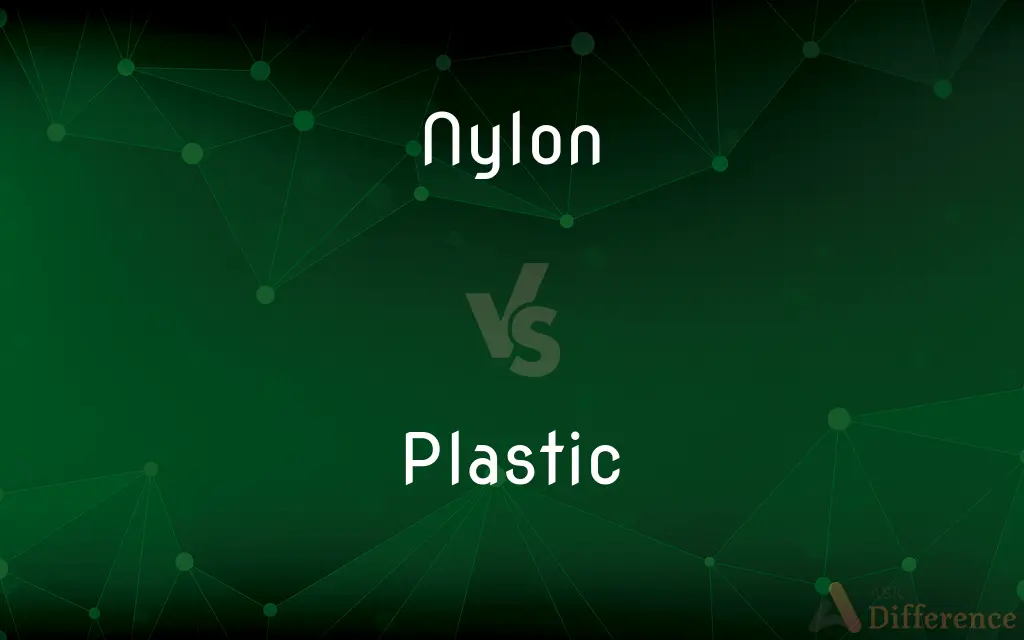Nylon vs. Plastic — What's the Difference?
Edited by Tayyaba Rehman — By Fiza Rafique — Updated on September 25, 2023
Nylon is a synthetic polymer used as a fabric and in various products, while Plastic is a broad category of synthetic or semi-synthetic moldable materials.

Difference Between Nylon and Plastic
Table of Contents
ADVERTISEMENT
Key Differences
Nylon and Plastic both belong to the wide realm of synthetic materials, but they differ fundamentally in their applications and characteristics. Nylon is a specific kind of polymer that has found extensive use in textiles due to its strength and flexibility. In contrast, Plastic is a general term, covering a vast array of synthetic or semi-synthetic materials that can be molded when soft and then set into a rigid or slightly elastic form.
Delving into the world of textiles, Nylon stands out as a revolutionary invention. This synthetic fiber, famed for its resilience and durability, quickly found its way into garments, ropes, and even parachutes. Plastic, on the other hand, has a more diverse range of applications, from packaging to automotive components, toys to medical devices, emphasizing its versatility.
Chemically, Nylon is a polyamide, formed by repeating units linked by amide bonds. Its discovery was groundbreaking, offering an alternative to natural silk. Plastic, encompassing various polymers like polyethylene, PVC, and polystyrene, can vary greatly in its chemical composition, making it suitable for myriad applications.
Both Nylon and Plastic have raised environmental concerns, primarily due to their non-biodegradable nature. However, the global dependence on these materials, especially Plastic, has driven industries towards recycling and creating biodegradable alternatives to mitigate their environmental impact.
Comparison Chart
Nature
A specific type of polymer
Broad category of moldable materials
ADVERTISEMENT
Primary Use
Textiles and some industrial applications
Wide variety of applications
Chemical Structure
Polyamide
Varies (e.g., polyethylene, PVC, polystyrene)
Environmental Concern
Non-biodegradable
Mostly non-biodegradable
Example Products
Clothing, ropes, toothbrush bristles
Bottles, toys, furniture, packaging
Compare with Definitions
Nylon
A material known for its strength and elasticity.
The climber used a nylon rope for safety.
Plastic
A synthetic or semi-synthetic moldable material.
Plastic bottles are commonly used for beverages.
Nylon
A synthetic polymer used mainly as a textile fiber.
Nylon stockings became popular in the 20th century.
Plastic
A term describing materials that can be easily shaped.
The artist used plastic clay to create sculptures.
Nylon
An alternative to natural silk.
Nylon parachutes replaced silk ones during WWII.
Plastic
Often categorized by its polymer type.
PVC plastic is used in making pipes and fittings.
Nylon
Nylon is a generic designation for a family of synthetic polymers composed of polyamides (repeating units linked by amide links). Nylon is a silk-like thermoplastic, generally made from petroleum, that can be melt-processed into fibers, films, or shapes.
Plastic
Plastics are a wide range of synthetic or semi-synthetic materials that use polymers as a main ingredient. Their plasticity makes it possible for plastics to be moulded, extruded or pressed into solid objects of various shapes.
Nylon
Any of a family of high-strength, resilient synthetic polymers, the molecules of which contain the recurring amide group CONH.
Plastic
A synthetic material made from a wide range of organic polymers such as polyethylene, PVC, nylon, etc., that can be moulded into shape while soft, and then set into a rigid or slightly elastic form
Mains pipes should be made of plastic or copper
Bottles can be made from a variety of plastics
Nylon
Cloth or yarn made from one of these synthetic materials.
Plastic
Made of plastic
Plastic bottles
Nylon
Nylons Stockings made of one of these synthetic materials.
Plastic
(of a substance or material) easily shaped or moulded
Rendering the material more plastic
Nylon
Originally, the DuPont company trade name for polyamide, a copolymer whose molecules consist of alternating diamine and dicarboxylic acid monomers bonded together; now generically used for this type of polymer.
Plastic
Capable of being shaped or formed
Plastic material such as clay.
Nylon
(in the plural) A stocking originally fabricated from nylon; also used generically for any long, sheer stocking worn on a woman's legs.
I tore a hole in my nylons while walking home through the woods.
Plastic
Relating to or dealing with shaping or modeling
The plastic art of sculpture.
Nylon
(perjoratively, by comparison to silk) A Queen's Counsel, King's Counsel or Senior Counsel who was appointed as a courtesy, rather than on merit.
Plastic
Having the qualities of sculpture; well-formed
"the astonishing plastic beauty of the chorus girls" (Frank Harris).
Nylon
Any of several thermoplastic polyamide plastics, comprising a family of high-strength resilient synthetic materials, used mostly in fibers.
Plastic
Giving form or shape to a substance
The plastic forces that create and wear down a mountain range.
Nylon
A synthetic fabric consisting of fibers of nylon[wn1].
Plastic
Easily influenced; impressionable
"The plastic mind of the bank clerk had been ... distorted by what he had read" (Rudyard Kipling).
Nylon
Stockings made of a thin form of nylon{2}, especially full-length stockings either sheer of of varying shades.
Plastic
Made of a plastic or plastics
A plastic garden hose.
Nylon
A thermoplastic polyamide; a family of high-strength resilient synthetic materials
Plastic
(Physics) Capable of undergoing continuous deformation without rupture or relaxation.
Nylon
A synthetic fabric
Plastic
Capable of building tissue; formative.
Nylon
A polyamide with repeating units linked by amide bonds.
Nylon's chemical structure makes it durable.
Plastic
Able to change and adapt, especially by acquiring alternative pathways for sensory perception or motor skills. Used of the central nervous system.
Nylon
Used in various non-textile products like brushes.
Many toothbrush bristles are made of nylon.
Plastic
Marked by artificiality or superficiality
A plastic world of fad, hype, and sensation.
Plastic
(Informal) Of or obtained by means of credit cards
Plastic money.
Plastic
Any of various organic compounds produced by polymerization, capable of being molded, extruded, cast into various shapes and films, or drawn into filaments used as textile fibers.
Plastic
(Informal) A credit card or credit cards
Would accept cash or plastic in payment.
Plastic
A synthetic, solid, hydrocarbon-based polymer, whether thermoplastic or thermosetting.
Plastic
Credit or debit cards used in place of cash to buy goods and services.
Plastic
Insincerity; fakeness, or a person who is fake or arrogant, or believes that they are better than the rest of the population.
Plastic
An instance of plastic surgery.
Plastic
(obsolete) A sculptor, moulder.
Plastic
(archaic) Any solid but malleable substance.
Plastic
Capable of being moulded; malleable, flexible, pliant.
Plastic
Producing tissue.
Plastic
(dated) Creative, formative.
Plastic
(biology) Capable of adapting to varying conditions; characterized by environmental adaptability.
Plastic
Of or pertaining to the inelastic, non-brittle, deformation of a material.
Plastic
Made of plastic.
Plastic
Inferior or not the real thing.
Plastic
Fake; insincere.
Plastic
Having the power to give form or fashion to a mass of matter; as, the plastic hand of the Creator.
See plastic Nature working to his end.
Plastic
Capable of being molded, formed, or modeled, as clay or plaster; - used also figuratively; as, the plastic mind of a child.
Plastic
Pertaining or appropriate to, or characteristic of, molding or modeling; produced by, or appearing as if produced by, molding or modeling; - said of sculpture and the kindred arts, in distinction from painting and the graphic arts.
Medallions . . . fraught with the plastic beauty and grace of the palmy days of Italian art.
Plastic
A substance composed predominantly of a synthetic organic high polymer capable of being cast or molded; many varieties of plastic are used to produce articles of commerce (after 1900). [MW10 gives origin of word as 1905]
Plastic
Generic name for certain synthetic or semisynthetic materials that can be molded or extruded into objects or films or filaments or used for making e.g. coatings and adhesives
Plastic
Used of the imagination;
Material...transformed by the plastic power of the imagination
Plastic
Capable of being molded or modeled (especially of earth or clay or other soft material);
Plastic substances such as wax or clay
Plastic
Capable of being influenced or formed;
The plastic minds of children
A pliant nature
Plastic
Derived from petrochemicals or organic polymers.
The plastic toy was made from polyethylene.
Plastic
Known for its versatility in manufacturing.
Plastic chairs come in various shapes and colors.
Common Curiosities
Is nylon a type of plastic?
Nylon is a specific synthetic polymer, while plastic is a broad term for moldable materials.
What's the primary use of nylon?
Nylon is mainly used in textiles due to its strength and flexibility.
Are all plastics harmful to the environment?
Most plastics are non-biodegradable, but there are biodegradable plastics available.
What makes nylon strong?
Its polyamide structure with repeating units linked by amide bonds.
Can nylon be recycled?
Yes, nylon can be recycled, though the process can be complex.
Which is more versatile: nylon or plastic?
Plastic, due to its vast array of types and applications.
Can nylon replace silk?
Yes, nylon was developed as a synthetic alternative to silk.
Is nylon resistant to wear and tear?
Yes, nylon is known for its durability and resilience.
How many types of plastics exist?
There are numerous types, including polyethylene, PVC, and polystyrene.
Is plastic derived only from petrochemicals?
Mostly, but there are bio-based plastics made from renewable resources.
Are plastics used in medical applications?
Yes, plastics are used in various medical devices and equipment.
Why is plastic popular in packaging?
Plastic is lightweight, versatile, and can be molded easily.
Are there environmental concerns with nylon production?
Yes, its production can be energy-intensive and non-biodegradable waste is a concern.
Can both nylon and plastic be dyed?
Yes, both can be dyed, but the processes and dyes may vary.
Is nylon used in the automotive industry?
Yes, it's used in various components due to its strength.
Share Your Discovery

Previous Comparison
Grantor vs. Grantee
Next Comparison
Priest vs. BishopAuthor Spotlight
Written by
Fiza RafiqueFiza Rafique is a skilled content writer at AskDifference.com, where she meticulously refines and enhances written pieces. Drawing from her vast editorial expertise, Fiza ensures clarity, accuracy, and precision in every article. Passionate about language, she continually seeks to elevate the quality of content for readers worldwide.
Edited by
Tayyaba RehmanTayyaba Rehman is a distinguished writer, currently serving as a primary contributor to askdifference.com. As a researcher in semantics and etymology, Tayyaba's passion for the complexity of languages and their distinctions has found a perfect home on the platform. Tayyaba delves into the intricacies of language, distinguishing between commonly confused words and phrases, thereby providing clarity for readers worldwide.
















































